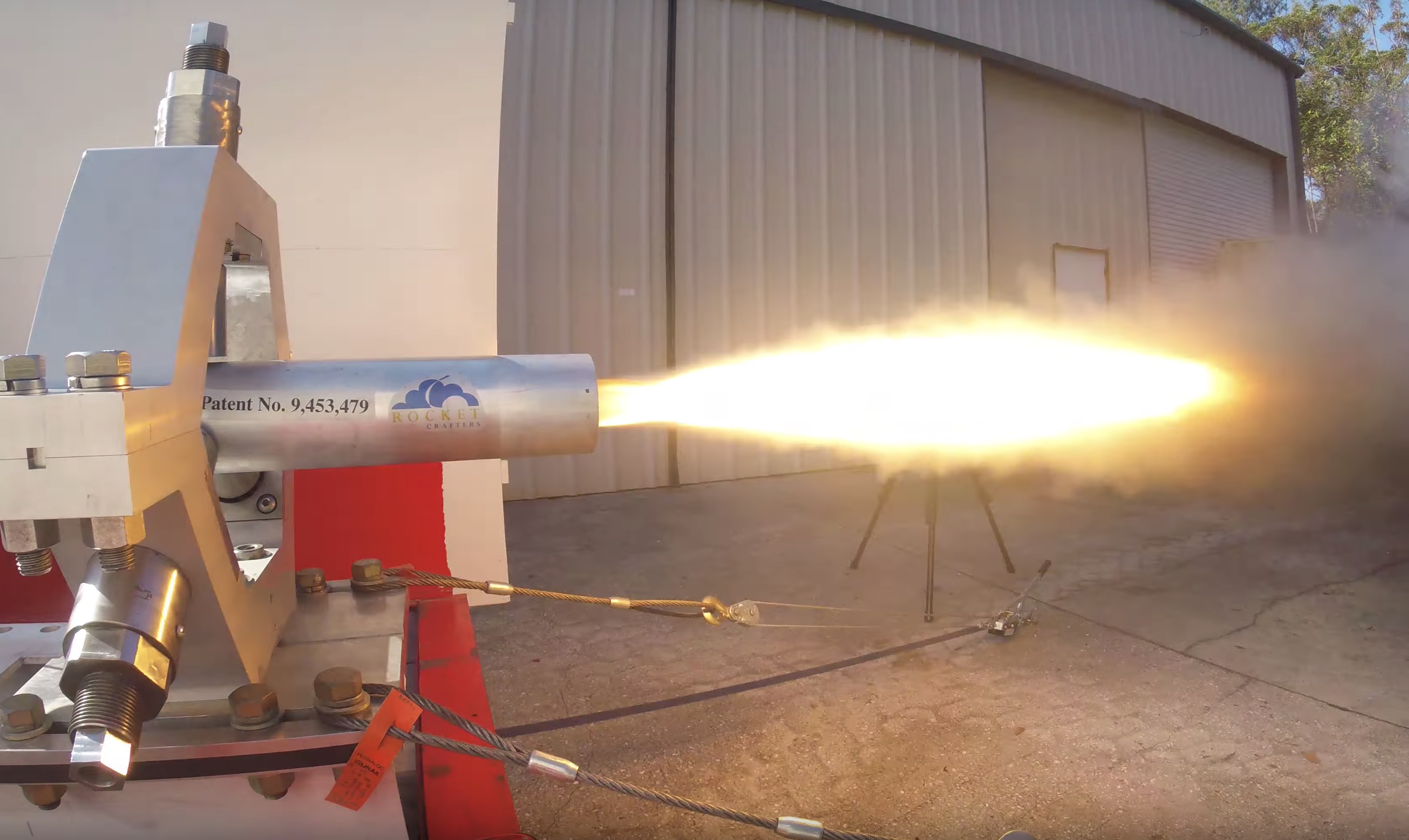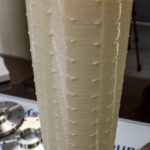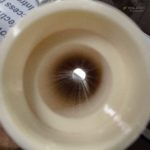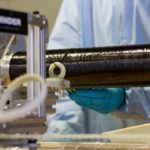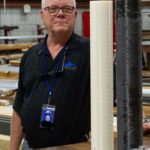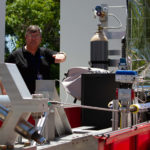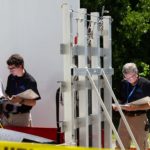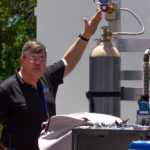I had a rare opportunity to visit Rocket Crafters, a small rocket company located in Cocoa, Florida, just 10 miles from the Kennedy Space Center, that is developing and testing what is known as ‘hybrid rocket engines’. These 3D printed engines are born in Colorado from a custom-made printer because none exist on the market that’s large enough to print these rocket engines that DARPA contracts them to build, with a $600,000 investment.
After the hybrid fuel grains are printed, they’re shipped to Rocket Crafters in Florida where they are further processed by wrapping them in carbon for additional strengthening and then test fired. The company is testing three engines per week at an industrial location in the city of Cocoa. The only requirement the City has for testing these engines is to keep the noise level below a certain decibel, over concerns of disruption to neighboring residential.
The engines, called fuel grains, are tubes made of ABS plastic, the same material LEGO are made of. The fuel grains are so safe, in fact, they can fly with them on airplanes as a carry on. They are specially shaped for the use of burning smoothly as a rocket engine, something only a printing process could form, which is a patented invention by Ronald Jones. The fuel grain needs an oxidizer in order to burn through, and without that, there’s really not much you can do with them because they’re just a tube of plastic.
- Rocket Crafters engine is a Patented printing process. (Tom Cross)
- A look inside the fuel grain. (Tom Cross)
- A fuel grain in the process of carbon-wrapping. (Tom Cross)
- Inventor, Ronald Jones. (Tom Cross)
When I arrived at Rocket Crafters the day of the test, I asked if I could set up my launchpad cameras to capture the flame of the engine during the test fire. Due to safety concerns over their oxidizer tanks that were already full, the team kindly advised against doing so. The oxidizer is nitrous oxide, also known as laughing gas at the dentist. Needless to say, it probably would have been incredibly funny had it sprung a leak while I was setting up my camera. The whole test stand sits on the back of a flat-bed trailer that’s ratcheted down to the concrete and protected by mobile steel walls on three sides.
- Rocket Crafters engine test stand. (Tom Cross)
- Technicians take readings from the gauges on the test stand. (Tom Cross)
CEO Sid Gutierrez, a former Space Shuttle Pilot, and Shuttle Commander touted the safety aspects of their rocket engine. “What you won’t see are cryogenics, bi-propellant liquid fuel engines, no signs saying explosives,” he said during the video conference. Rocket Crafters are carving their slice into the new wave of affordable launches for small-scale cube satellites and have grand plans of creating their own rocket called Intrepid consisting of multiple hybrid rocket engines burning simultaneously.
They brought me into their testing facility to showcase their fuel grains, carbon wrapping process, and most importantly a 10-second test fire of one of the engines from inside their control room. During the test, the engine could be heard through multiple block walls and doors as if it was just 10 feet away. The building didn’t shake, the sound was intense, though. The video on the screen doesn’t do it justice. The whole experience was pretty awesome.
Rocket Crafters still has a bit of work to do trying and testing new components before they’re ready to launch but they’ve already begun making prototypes of their full-scale engine. The day I was there, engineers were testing a nozzle made of a material they hadn’t tried before. “You don’t see many 15-person companies developing a rocket,” said Robert Fabian, SVP of Propulsion.
I’m no rocket expert, I’d be a rocket scientist instead of a photographer if so, but I learn a lot by doing this. I think this particular hybrid rocket engine would be perfectly suited for a prosumer market of amateur rocketry, especially considering how safe they are and non-toxic to the environment. The few amateur rocket enthusiasts I’ve asked about hybrid engines said they’d be great to have after they fix the flaws of hybrid engines.
Here’s a video of one of their engine tests:
https://youtu.be/BVPxbdkC1y8
Tom Cross
Lifestyle
EV fans urge Tesla to acquire Unplugged Performance for edge in fleet and security industry
Unplugged Performance has built a name for itself by producing performance upgrades for Tesla vehicles.
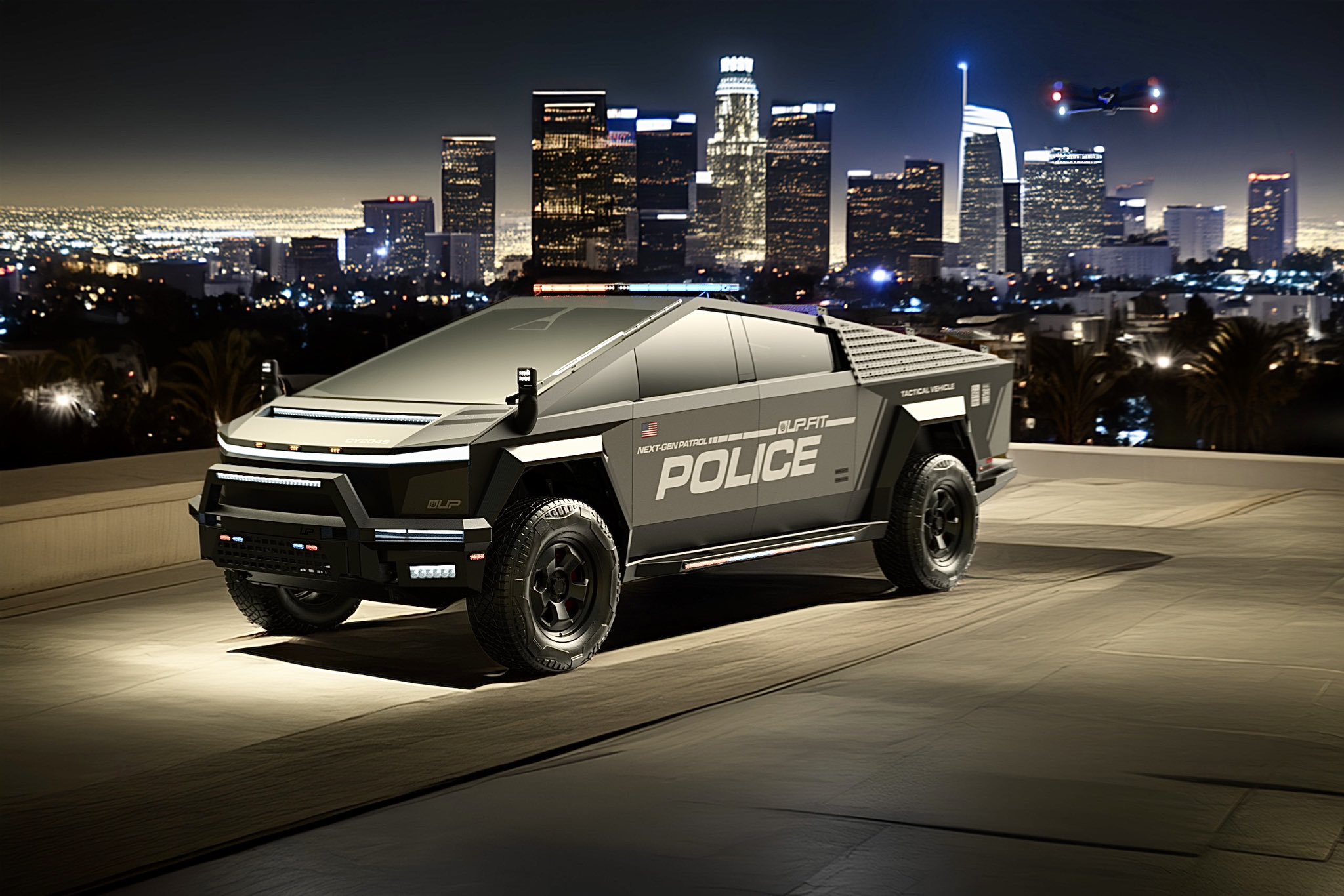
A growing number of Tesla enthusiasts and longtime community voices are calling on the electric vehicle maker to acquire Unplugged Performance, a California-based aftermarket company best known for tuning Tesla vehicles and developing specialized government fleet solutions under its UP.FIT division.
The idea was once considered a niche proposal among EV fans, but it is now gaining serious attention not just as a performance play but as a strategic move to deepen Tesla’s roots in the fleet and security industry.
A strategic fit
Unplugged Performance has built a name for itself by producing performance upgrades for Tesla vehicles, from track-optimized components to visual and aerodynamic upgrades. But in recent years, its UP.FIT division has pivoted toward a more functional future by outfitting Tesla vehicles like Model Ys for police, military, and government use.
That work has sparked growing calls for closer collaboration with Tesla, especially as the EV maker increasingly leans into autonomy, AI, and fleet services as core components of its next chapter.
“I posted this four years ago, but I think it’s more true now than ever,” wrote Whole Mars Catalog, a well-known Tesla investor and FSD Beta tester, on X. “Tesla should buy Unplugged. But not just as a Performance division. What they are doing with UP.FIT unlocks large government and commercial fleet purchases that can improve utilization.”
Tesla fans such as shareholder Sawyer Merritt echoed the sentiment, calling Unplugged a “great fit within Tesla.” adding, “They are literally located directly next to Tesla’s design studio in Hawthorne.”
Enabling the next wave
Supporters of the idea noted that integrating Unplugged into Tesla’s corporate structure could help accelerate the adoption of autonomous technologies in government sectors. With UP.FIT patrol cars already in use across some U.S. police departments, Tesla fans envisioned a future where self-driving Teslas could potentially revolutionize law enforcement, search-and-rescue, and public service logistics.
“Just imagine how autonomous patrol cars could transform policing and bring us into a safer future,” the veteran FSD tester wrote.
The benefits could also extend to Tesla’s existing consumer base. “They also have some incredible products in the works that I think will appeal to many ordinary Tesla drivers — not just those looking for performance or mods. Stuff that’s so good it should have come straight from the design studio next door,” Whole Mars Catalog noted.
Unplugged Performance, founded in 2013, shares not just a product vision with Tesla, but also geography. Its Hawthorne headquarters sits directly adjacent to Tesla’s design studio, and the two companies have maintained a close working relationship over the years. The aftermarket firm has long positioned itself as a “mission-aligned” partner to Tesla.
In response to the recent calls for acquisition, Unplugged Performance acknowledged the support from the community. “Our very existence is to support the Tesla mission with @UpfitTesla and @UnpluggedTesla,” Unplugged CEO Ben Schaffer posted on X. “We love working with Tesla and are grateful for the community’s support since 2013!”
Elon Musk
X account with 184 followers inadvertently saves US space program amid Musk-Trump row
Needless to say, the X user has far more than 184 followers today after his level-headed feat.

An X user with 184 followers has become the unlikely hero of the United States’ space program by effectively de-escalating a row between SpaceX CEO Elon Musk and President Donald Trump on social media.
Needless to say, the X user has far more than 184 followers today after his level-headed feat.
A Near Fall
During Elon Musk and Donald Trump’s fallout last week, the U.S. President stated in a post on Truth Social that a good way for the United States government to save money would be to terminate subsidies and contracts from the CEO’s companies. Musk responded to Trump’s post by stating that SpaceX will start decommissioning its Dragon spacecraft immediately.
Musk’s comment was received with shock among the space community, partly because the U.S. space program is currently reliant on SpaceX to send supplies and astronauts to the International Space Station (ISS). Without Dragon, the United States will likely have to utilize Russia’s Soyuz for the same services—at a significantly higher price.
X User to the Rescue
It was evident among X users that Musk’s comments about Dragon being decommissioned were posted while emotions were high. It was then no surprise that an X account with 184 followers, @Fab25june, commented on Musk’s post, urging the CEO to rethink his decision. “This is a shame this back and forth. You are both better than this. Cool off and take a step back for a couple days,” the X user wrote in a reply.
Much to the social media platform’s surprise, Musk responded to the user. Even more surprising, the CEO stated that SpaceX would not be decommissioning Dragon after all. “Good advice. Ok, we won’t decommission Dragon,” Musk wrote in a post on X.
Not Planned, But Welcomed
The X user’s comment and Musk’s response were received extremely well by social media users, many of whom noted that @Fab25june’s X comment effectively saved the U.S. space program. In a follow-up comment, the X user, who has over 9,100 followers as of writing, stated that he did not really plan on being a mediator between Musk and Trump.
“Elon Musk replied to me. Somehow, I became the accidental peace broker between two billionaires. I didn’t plan this. I was just being me. Two great minds can do wonders. Sometimes, all it takes is a breather. Grateful for every like, DM, and new follow. Life’s weird. The internet’s weirder. Let’s ride. (Manifesting peace… and maybe a Model Y.)” the X user wrote.
Lifestyle
Tesla Cybertruck takes a bump from epic failing Dodge Charger
The Cybertruck seemed unharmed by the charging Charger.
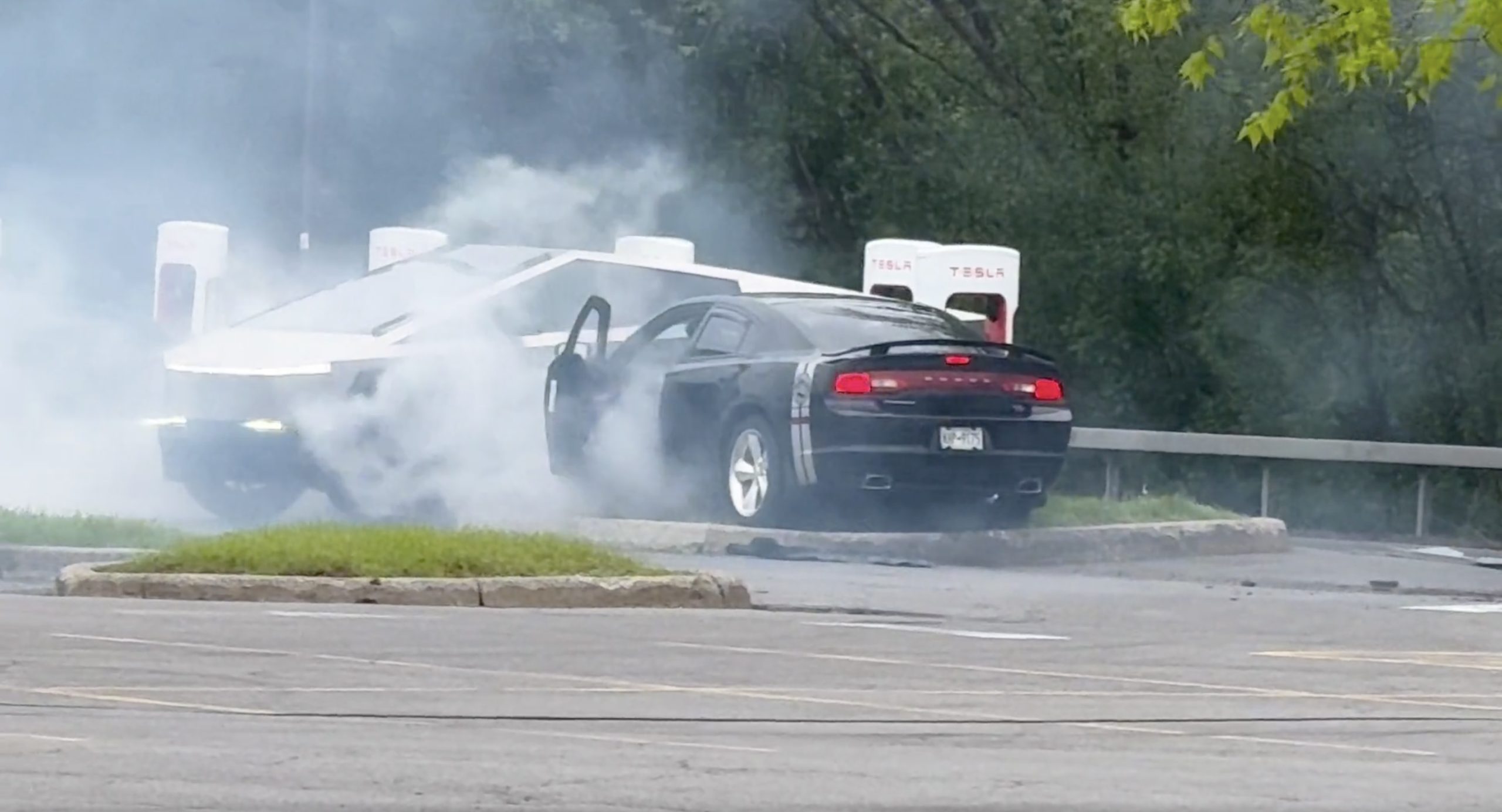
There comes a time in a driver’s life when one is faced with one’s limitations. For the driver of a Dodge Charger, this time came when he lost control and crashed into a Tesla Cybertruck–an absolute epic fail.
A video of the rather unfortunate incident was shared on the r/TeslaLounge subreddit.
Charging Charger Fails
As could be seen in the video, which was posted on the subreddit by Model Y owner u/Hammer_of_something, a group of teens in a Dodge Charger decided to do some burnouts at a Tesla Supercharger. Unfortunately, the driver of the Charger failed in his burnout or donut attempt, resulting in the mopar sedan going over a curb and bumping a charging Cybertruck.
Ironically, the Dodge Charger seemed to have been parked at a Supercharger stall before its driver decided to perform the failed stunt. This suggests that the vehicle was likely ICE-ing a charging stall before it had its epic fail moment. Amusingly enough, the subreddit member noted that the Cybertruck did not seem like it took any damage at all despite its bump. The Charger, however, seemed like it ran into some trouble after crashing into the truck.
Alleged Aftermath
As per the the r/TeslaLounge subreddit member, the Cybertruck owner came rushing out to his vehicle after the Dodge Charger crashed into it. The Model Y owner then sent over the full video of the incident, which clearly showed the Charger attempting a burnout, failing, and bumping into the Cybertruck. The Cybertruck owner likely appreciated the video, in part because it showed the driver of the Dodge Charger absolutely freaking out after the incident.
The Cybertruck is not an impregnable vehicle, but it can take bumps pretty well thanks to its thick stainless steel body. Based on this video, it appears that the Cybertruck can even take bumps from a charging Charger, all while chilling and charging at a Supercharger. As for the teens in the Dodge, they likely had to provide a long explanation to authorities after the incident, since the cops were called to the location.
-

 Elon Musk1 day ago
Elon Musk1 day agoWaymo responds to Tesla’s Robotaxi expansion in Austin with bold statement
-
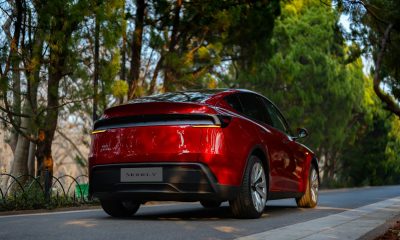
 News1 day ago
News1 day agoTesla exec hints at useful and potentially killer Model Y L feature
-
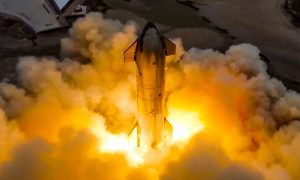
 Elon Musk2 days ago
Elon Musk2 days agoElon Musk reveals SpaceX’s target for Starship’s 10th launch
-

 Elon Musk3 days ago
Elon Musk3 days agoTesla ups Robotaxi fare price to another comical figure with service area expansion
-

 News1 day ago
News1 day agoTesla’s longer Model Y did not scale back requests for this vehicle type from fans
-

 News1 day ago
News1 day ago“Worthy of respect:” Six-seat Model Y L acknowledged by Tesla China’s biggest rivals
-
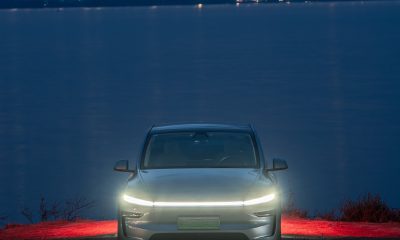
 News2 days ago
News2 days agoFirst glimpse of Tesla Model Y with six seats and extended wheelbase
-
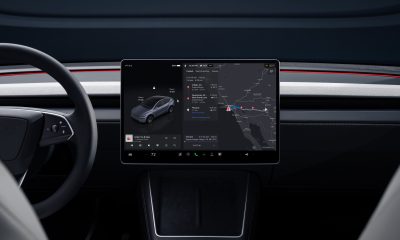
 Elon Musk2 days ago
Elon Musk2 days agoElon Musk confirms Tesla is already rolling out a new feature for in-car Grok

